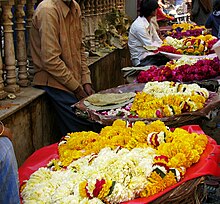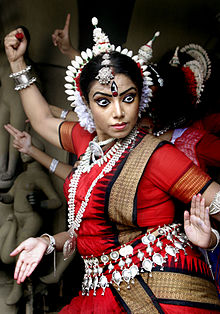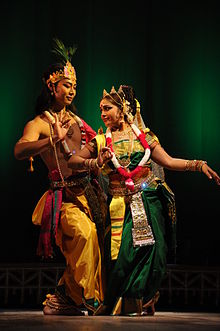Hindu art
Hindu art
Jump to navigation
Jump to search
This article may require cleanup to meet Wikipedia's quality standards. (April 2009) (Learn how and when to remove this template message) |
| Part of a series on |
| Hinduism |
|---|
 |
|
Concepts
|
Schools
|
Deities
|
Texts Scriptures
Other texts
Text classification
|
Practices Worship
Arts
Rites of passage
Festivals
|
Gurus, saints, philosophers
|
Society
|
Other topics
|
|
Hindu art encompasses the artistic traditions and styles culturally connected to Hinduism and have a long history of religious association with Hindu scriptures, rituals and worship.
Contents
1 Background
2 Popular Dance and Music Art Forms
3 64 Traditional Arts[3]
4 Historic Texts on Art Practices
5 Cities Dedicated to the Production of Art
6 Common Symbols
7 See also
8 References
Background[edit]
Hinduism, with its 1 billion followers, it makes up about 15% of the world’s population[1] and as such the culture that ensues it is full of different aspects of life that are effected by art. There are 64 traditional arts that are followed that start with the classics of music and range all the way to the application and adornment of jewelry.[2] Since religion and culture are inseparable with Hinduism recurring symbols such as the gods and their reincarnations, the lotus flower, extra limbs, and even the traditional arts make their appearances in many sculptures, paintings, music, and dance.
| Part of a series on |
| Hindu Classical Arts |
|---|
 |
|
Popular Dance and Music Art Forms[edit]
Natya Shastra and centuries of Hindu cultural traditions have given rise to several art forms. Some of which are:
- Bharatanatyam
- Kuchipudi
- Manipuri
- Mohiniyattam
- Odissi
- Sattriya
- Bhagavata Mela
- Yakshagana
- Carnatic Music

floral decoration

A Hindu dance depicting the goddess Durga
64 Traditional Arts[3][edit]

Hindu dances as part of ritual
- Singing
- Instrumental music
- Learning music in Hindu culture was a difficult task before the 20th century because of a necessary birth into a gharana. After the early 1920s integration of anyone wanting to learn classical Hindustani music could. An average ensemble normally includes a harmonium (which was brought to India by westerners), flute, veena, sitar, swaramandala, and a tabla. Many of the songs have strong themes that are related to theology such as a god’s favorite pastimes, praise of any god whether they be in their original form from “the trinity” or the god's reincarnation, even stories of the creation of earth. Since instrumental music is a performance art it must follow strict guidelines that come from the treatise Natya Shastra.[4]
- Dancing
- Painting
- Indian variety - the different types of folk paintings are proud for Indian culture which reflects beauty, tradition and heritage of India. There are many types of traditional paintings like Madhubani, Rajsthani, Batik-Art, Patachitra, Gond, Mandala, Tribal Art Warli, Pithora, Bengali, Nirmal, Mysore, Tanjore paintings etc. which are the expressions of love, almighty, beauty, truth, tradition and art of each and every region of the India.
- Forehead adornments
- Making decorative floral and grain designs on the floor
- Home and temple flower arranging
- Personal grooming
- Mosaic tiling
- Bedroom arrangements
- Creating music with water
- Splashing and squirting with water
- Secret mantras
- Making flower garlands
- Head adornments
- Dressing
- Drapery- The art of drapery has progressed over time. At one point both men and women wore dhotis but around the 14th century that changed and women’s fashion became more intricate thus creating the sari. The drapery involved distinguishes the wearer’s taste, occupation, and social status. The fabrics chosen range from cotton and synthetic fabrics all the way to silk. The fabric chosen depends on what occasion the wearer is going to use the item of clothing for. The draping of the sari comes in four different families: Marvari, Dravidian, Tribal, and Nivi. The family that the wearer chooses depends on the wearer’s personal taste. The way an item of clothing is draped tells a lot about the wearer such as expression of creativity, progression of fashion, and where the user comes from.[5]
- Costume decorations
- Perfumery
- Jewelry making
- Magic and illusions
- Ointments for charm and virility
- Manual dexterity
- Skills of cooking, eating and drinking
- Beverage and dessert preparation
- Sewing (making and mending garments)
- Embroidery
- Playing Vina and drum
- Riddles and rhymes
- Poetry games
- Tongue twisters and difficult recitation
- Literary recitation
- Drama and story telling
- Drama in its early essence was performed mainly by male troupes and was often integrated with many of the other traditional art forms such as poetry, music, and story telling. Since drama is a performance art it also follows the Natya Shastra guidelines.[6]
- Verse composition games
- Furniture caning
- Erotic devices and knowledge of sexual arts
- Crafting wooden furniture
- Architecture and house construction
- Distinguishing between ordinary and precious stones and metals
- Metal-working
- Gems and mining
- Gardening and horticulture
- Games of wager involving animals
- Training parrots and mynas to speak
- Hairdressing
- Coding messages
- Speaking in code
- Knowledge of foreign languages and dialects
- Making flower carriages
- Spells, charms and omens
- Making simple mechanical devices
- Memory training
- Game of reciting verses from hearing
- Decoding messages
- The meanings of words
- Dictionary studies
- Prosody and rhetoric
- Impersonation
- Artful dressing
- Games of dice
- The game of akarsha (a dice game played on a board)
- Making dolls and toys for children
- Personal etiquette and animal training
- Knowledge of dharmic warfare and victory
- Physical culture
The names and meanings of all the 64 Arts
(1) gita — art of singing.
(2) vadya — art of playing on musical instruments.
(3) nritya — art of dancing.
(4) natya — art of theatricals.
(5) alekhya — art of painting.
(6) viseshakacchedya — art of painting the face and body with colored unguents and cosmetics.
(7) tandula-kusuma-bali-vikara — art of preparing offerings from rice and flowers.
(8) pushpastarana — art of making a covering of flowers for a bed.
(9) dasana-vasananga-raga — art of applying preparations for cleansing the teeth, cloths and painting the body.
(10) mani-bhumika-karma — art of making the jewel garlands.
(11) sayya-racana — art of covering the bed.
(12) udaka-vadya — art of playing on music in water.
(13) udaka-ghata — art of splashing water on ground.
(14) citra-yoga — art of practically applying an admixture of colors.
(15) malya-grathana-vikalpa — art of designing a preparation of wreaths or garlands.
(16) sekharapida-yojana — art of practically setting the coronet on the head.
(17) nepathya-yoga — art of practically dressing
(18) karnapatra-bhanga — art of decorating the tragus of the ear.
(19) sugandha-yukti — art of practical application of aromatics.
(20) bhushana-yojana — art of applying or setting ornaments.
(21) aindra-jala — art of jugglery.
(22) kaucumara — a kind of art.
(23) hasta-laghava — art of sleight of hand.
(24) citra-sakapupa-bhakshya-vikara-kriya — art of preparing varieties of foods - curries, soups, sweetmeats
(25) panaka-rasa-ragasava-yojana — art of preparing palatable drinks and fruit juices
(26) suci-vaya-karma — art of needleworks and weaving.
(27) sutra-krida — art of playing with thread.
(28) vina-damuraka-vadya — art of playing on lute and small x-shaped drum.
(29) prahelika — art of making and solving riddles.
(29-a) pratimala — art of caping or reciting verse for verse as a trial for memory or skill.
(30) durvacaka-yoga — art of practicing language difficult to be answered by others.
(31) pustaka-vacana — art of reciting books.
(32) natikakhyayika-darsana — art of enacting short plays and anecdotes.
(33) kavya-samasya-purana — art of solving enigmatic verses.
(34) pattika-vetra-bana-vikalpa — art of designing preparation of shield, cane and arrows.
(35) tarku-karma — art of spinning by spindle.
(36) takshana — art of carpentry.
(37) vastu-vidya — art of engineering.
(38) raupya-ratna-pariksha — art of testing silver and jewels.
(39) dhatu-vada — art of metallurgy.
(40) mani-raga jnana — art of judging jewels.
(41) akara jnana — art of mineralogy.
(42) vrikshayur-veda-yoga — art of practicing medicine or medical treatment, by herbs.
(43) mesha-kukkuta-lavaka-yuddha-vidhi — art of knowing the mode of fighting of lambs, cocks and birds.
(44) suka-sarika-prapalana (pralapana)? — art of maintaining or knowing conversation between male and female cockatoos.
(45) utsadana — art of healing or cleaning a person with perfumes.
(46) kesa-marjana-kausala — art of combing hair.
(47) akshara-mushtika-kathana — art of talking with fingers.
(48) mlecchita-kutarka-vikalpa — art of fabricating barbarous or foreign sophistry.
(49) desa-bhasha-jnana — art of knowing provincial dialects.
(50) pushpa-sakatika-nirmiti-jnana — art of knowing prediction by heavenly voice or knowing preparation of toy carts by flowers.
(51) yantra-matrika — art of mechanics.
(52) dharana-matrika — art of the use of amulets.
(53) samvacya — art of conversation.
(54) manasi kavya-kriya — art of composing verse mentally.
(55) kriya-vikalpa — art of designing a literary work or a medical remedy.
(56) chalitaka-yoga — art of practicing as a builder of shrines
(57) abhidhana-kosha-cchando-jnana — art of the use of lexicography and meters.
(58) vastra-gopana — art of concealment of cloths.
(59) dyuta-visesha — art of knowing specific gambling.
(60) akarsha-krida — art of playing with dice or magnet.
(61) balaka-kridanaka — art of using children’s toys.
(62) vainayiki vidya — art of enforcing discipline.
(63) vaijayiki vidya — art of gaining victory.
(64) vaitaliki vidya — art of awakening master with music at dawn
(65) aaaah vidya — art of awakening sound from Mani.
Historic Texts on Art Practices[edit]
- Natya Shastra
- The Natya Shastra is the leading guide to the Hindu performing arts. It is based on the Natya Veda, which no longer exists, and is roughly 37 chapters long with 6,000 slokas.[7]
Cities Dedicated to the Production of Art[edit]
- Raghupajpur
- This city is solely dedicated to the production of artwork that is driven by the divine forces of Hinduism and these artworks are produced in a traditional fashion. The city is located in Eastern India (Orissa) and at one point this city was at risk of being completely destroyed due to British rule. During this time religion and the power of the kings were being overthrown and as such there was no reason for a city to exist whose main purpose is to supply traditional art. After this crisis occurred the city began to exclusively base itself on agriculture until a man named Jacnnath Mopatra led a training center for chitrakars. This revolution began production of the traditional art works once again in the 1950s and since the work being produced is known internationally.[8]
Common Symbols[edit]
- Extra Limbs-Extra limbs are seen on many of the Hindu deities in paintings and sculptures. The extra limbs show how much power the god is capable of because of their ability to perform many tasks at once. Such as the goddess Sarasvati always has a minimum of four arms. Two of the arms will be playing a vina, representing the tuning of her knowledge, prayer beads in another hand and a scripture in another, both of these items are used to represent her devotion to her spirituality. Since she is the goddess of learning and art we see that she is very capable and very powerful in her area of expertise.[9]
- Lotus Flower-The lotus flower is another common item seen constantly throughout the arts. The lotus flower represents purity, beauty, prosperity, fertility, and transcendence.[10] The reason the flower shows these attributes is due to the process in which the lotus flower goes through in order to blossom. The flower grows out of mud and rests atop the water in which it grows showing the hardship it must endure in order to achieve maximum beauty. Many deities have their name based on the Sanskrit word for lotus such as Lakshimi.[11]
See also[edit]
- Kalā
- Alpana
- Balinese art
- Art of Champa
- Jnana Vigraham
- Madhubani art
- Rangoli
- Tanjore painting
References[edit]
^ "The Global Religious Landscape - Hinduism". A Report on the Size and Distribution of the World’s Major Religious Groups as of 2010. The pew foundation. Retrieved 31 March 2013.
^ ”Heart of Hinduism: Sanskrit and Sanskriti (Culture).” 2004, 30 Mar 2009. < http://hinduism.iskcon.com/lifestyle/801.htm>.
^ Himalayan Academy. “Kala 64: Hindu - Hinduism Dictionary on Kala 64.” 20 Apr 2009 < http://www.experiencefestival.com/a/Kala_64/id/60455>.
^ Dr. Beck, Guy. “Hindu music, now and into the future.” Hinduism Today October/November/December 2007. 28-31. < http://www.hinduismtoday.com/modules/smartsection/item.php?itemid=1515>
^ Boulanger, Chantal. “The Remarkable Indian Art of Draping.” Hinduism Today. October/November/December 2008. 60-62. <http://www.hinduismtoday.com/modules/smartsection/item.php?itemid=3078>
^ “Dance and Drama.” Heart of Hinduism. 2004, 12 Mar 2009. < http://hinduism.iskcon.com/lifestyle/803.htm>
^ “Natya Shastra: Encyclopedia II.” 29 Apr 2009. < http://www.experiencefestival.com/a/Natya_Shastra_-_Text_and_title/id/1793036>
^ Dr. Mohanty, M.P. “Living, Painting, Worshipping Art.” Hinduism Today. July/August/September 2007. 54-59. <http://www.hinduismtoday.com/modules/smartsection/item.php?itemid=1562>
^ Stephen Knapp. “Saravasti, the Goddess of Learning.” 20 Mar 2009. < http://www.stephen-knapp.com/sarasvati_goddess_of_learning.htm>
^ Anil K. Goel, Lucknow. “God’s Favorite Flower.” Hinduism Today. 1999. 15 Apr 2009. < http://www.hinduismtoday.com/modules/smartsection/item.php?itemid=4411>.
^ “Lotus-Hindu Symbols” Religion Facts. 2007. 15 Apr 2009. < http://www.religionfacts.com/hinduism/symbols/lotus.htm>.
Categories:
- Hindu art
- Art by religion
- Art history
- Asian art
- Hindu culture
(window.RLQ=window.RLQ||).push(function()mw.config.set("wgPageParseReport":"limitreport":"cputime":"0.264","walltime":"0.333","ppvisitednodes":"value":729,"limit":1000000,"ppgeneratednodes":"value":0,"limit":1500000,"postexpandincludesize":"value":60444,"limit":2097152,"templateargumentsize":"value":1342,"limit":2097152,"expansiondepth":"value":15,"limit":40,"expensivefunctioncount":"value":4,"limit":500,"unstrip-depth":"value":0,"limit":20,"unstrip-size":"value":6157,"limit":5000000,"entityaccesscount":"value":0,"limit":400,"timingprofile":["100.00% 161.867 1 -total"," 51.48% 83.326 1 Template:Cleanup"," 25.74% 41.662 1 Template:Reflist"," 24.93% 40.358 2 Template:Main_other"," 23.38% 37.852 1 Template:Ambox"," 17.99% 29.122 1 Template:Cite_web"," 16.17% 26.167 1 Template:Hinduism"," 15.68% 25.380 2 Template:Sidebar_with_collapsible_lists"," 13.99% 22.639 1 Template:Category_handler"," 8.20% 13.270 1 Template:DMC"],"scribunto":"limitreport-timeusage":"value":"0.055","limit":"10.000","limitreport-memusage":"value":2523328,"limit":52428800,"cachereport":"origin":"mw2199","timestamp":"20180921211017","ttl":1900800,"transientcontent":false);mw.config.set("wgBackendResponseTime":86,"wgHostname":"mw2229"););

 Clash Royale CLAN TAG
Clash Royale CLAN TAG